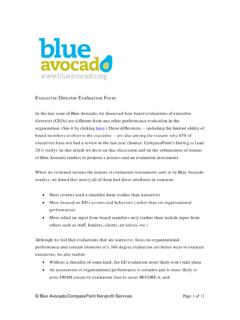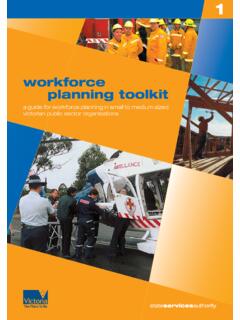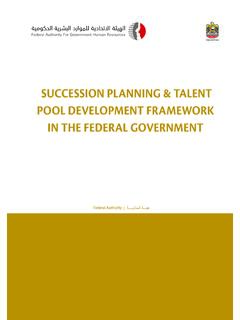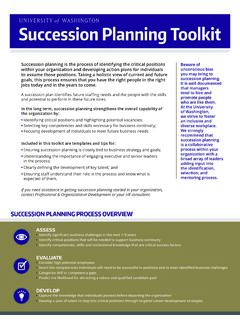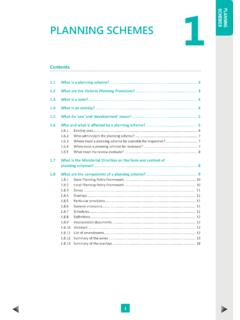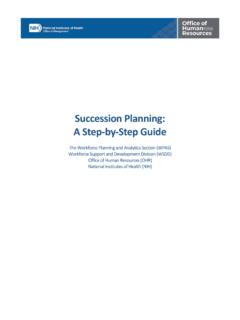Transcription of Guide to Succession Planning for Nonprofit Organizations
1 Guide to Succession Planning for Nonprofit OrganizationsA quick start framework to start and sustain Succession Succession Planning1An on-demand webinar accompanying this Guidebook is available here: to Use this GuideThis Guidebook provides tools, resources, further learning opportunities and templates throughout that are marked by these the author Amy Haile @ document is based on an exploratory study focused on Succession Planning completed as part of the requirements for a Doctorate of Public Health at the University of South Florida Like strategic and scenario Planning processes, Succession Planning is more an art than a science. Expect Succession Planning to be an iterative process. A Succession plan will mature with use and reflection. As you gain more experience in your role and as your organization changes, it is important to review and revise the plan. Plant the seed, water often and let it grow over with a risk prevention and management perspective by creating an emergency an existing framework that begins to grow leader regular conversations about Succession Planning with organization leadership.
2 Invest in executive coaching and begin legacy Planning .ToolsResourcesTemplatesTable of ContentsNonprofit Succession Planning301 Background Page 302 Guiding Principles Page 703 Making the Plan Work Page 1104 Strengthening DiversityPage 20050607 Example Plan Page 31 Tools & Resources Page 23 FAQPage 21 Change is InevitableExecutive Transition is comingNot Prepared for transitionOrganization is disruptedMission is impactedThe transition of an organization s chief executive officer (CEO) is likely to impact the organization s financial stability, strategic direction and levels of employee engagement. The Nonprofit workforce is retiring. 67% of CEOs in a national survey reported plans to leave their position within five years. Few Nonprofit Organizations are prepared for this transition. 27% of those Nonprofit Organizations surveyed have a written Succession plan.
3 Only 17% of smaller nonprofits (under $1m) have a plan. In the Tampa Bay region, there are more than 20,000 Nonprofit Organizations with revenue greater than $23B. 50% have a health, human services, public or societal benefit Succession Planning43 Critical Elements of Succession PlanningNonprofit Succession Planning5010203 Emergency Succession PlanningEnsuring key leadership and administrative functions can continue without disruption in the event of an unplanned, temporary DevelopmentOngoing practice to identify, recruit and develop individuals with the necessary skills to carry out the vision. Departure DefinedIdentifying the forward moving goals and determining the skill set required while building the capacity of organization s leadership and operations to sustain beyond the current executive s Planning Best PracticesNonprofit Succession Planning6 Overall Process Board-driven with CEO Ongoing communicationSelection Have potential successor(s) identifiedDevelopment Create and implement clear development plans and Succession timelinesMaintenance Develop a clear exit strategy for the incumbent executiveEvaluation Conduct post Succession assessment to identify potential problemsGuiding Principles Mission FirstCreate OpportunitiesLeadership Team DynamicsNonprofit Succession Planning7 Three guiding principles for creating a Succession plan emerged from conversations with Nonprofit executives.
4 Mission FirstStandard Bearer of the Mission The CEO is viewed as the standard bearer for the organization s mission and therefore responsible for cultivating the next generation of leaders by developing leadership within the organization and build senior leaders into a team to better serve the mission. As the torch holder for the mission, the CEO is responsible for assuring a common understanding of the mission among the organization s Sustainability during Transition CEO assures that systems are strong for maintaining regulatory compliance and back-ups are in place for critical operational functions. The CEO needs to identify his or her priority functions and create It is important for the CEOs to leave the place better than whence you found it can continue to grow . CEO should reflect and identify their key organizational accomplishments and milestones. CompassPoint offers The Executive Director Legacy Statement a tool with which an executive can clarify what he or she wants to accomplish before they CEOs need to create an opportunity to reflect on their motivation, energy and skills to serve the mission fully.
5 Executive coaches would provide objectivity in helping the CEO with this assessment. CompassPoint offers a self reflection tool Am I still the leader this agency needs? a resource and resources dedicated to coaching at the Coaching and Philanthropy Succession Planning8 Guiding PrincipleCreate OpportunitiesLeader Development CEO is responsible for cultivating the next generation of leaders for the mission a leadership-legacy . This effort is about being intentional and creating opportunities for leaders to emerge within the organization and with external relationships. It is also incumbent for CEOs to be mindful of creating equitable Leadership Project leadership is one of the purest forms of giving people opportunities to demonstrate leadership potential. Project-based assignments are a mechanism to create bridges for more employees to be visible within the organization as emerging leaders and one opportunity to attend to the concern of diversity and equity.
6 Stanford Social Innovation Review Five Ways to Build Diverse, Inclusive Leadership Teamsat The Bridgespan s Group How to How to Integrate Diversity, Equity, and Inclusion into Everyday Operationsat Training Professional development opportunities should be intentional with regards to leadership skills as well as skills specifically related to the understanding of budgets and financial practices. Nonprofit Leadership Center - Nonprofit Ready - Nonprofit Help Desk - Succession Planning9 Guiding PrincipleTeam DynamicsShared Leadership The CEO invests time and energy to develop relationships among the leadership team to expand the problem-solving capacity. Doing More with More: Putting Shared Leadership into Practiceat Sustainability The CEO is only one part of the leadership fabric of the organization. Succession Planning needs to include Planning for other key management and Board roles. This requires keeping in mind the sequence of departure of multiple key members of the organization, the retirement of the founding team.
7 Conduct annual performance evaluations that include a review of the current job description, emergency Succession plans and efforts to develop other Approach Understanding the organizational leadership is a dynamic organism and when one shifts it has an impact on the larger Succession Planning10 Guiding PrincipleMaking the Plan WorkNonprofit Succession Planning11 Key Tips to Executing a Quality Succession PlanSupporting StructuresExplore opportunities to build Succession Planning into existing organization processes. Emergency Planning Embed with another annual review process such as CEO performance evaluation, annual risk assessment or other. Include review of authorized signers, Board Policy on second and third in command, list of Planning documents, list of regulatory compliance documents. Annual Review Minimize threat perceived by Board or CEO by creating Succession Planning process as standard business practice. Create a routine review of the Succession plan and CEO job description with the Board s Executive Committee each year.
8 Legacy Check-In Create a routine review of the CEO s Legacy Statement with an executive coach to identify short term and long-term goals. Once initial coaching is complete, create a process for at least an annual check-in of the CEO with the Executive Coach to discuss progress and assess for burn-out. Nonprofit Succession Planning12 Making the Plan WorkCommunication Plan Communication is intentional and happens throughout the Planning and execution of a Succession plan. Communicate to key organizational stakeholders (employees, Board of Directors, key funders) that a Succession plan is in place to minimize stress associated with uncertainty. Create a communication plan of the steps to take during a transition that is included in your Succession plan and periodically reviewed and updated. Nonprofit Succession Planning13 Making the Plan WorkUse of Interim CEO Internal vs. External: An interim CEO can be internal or external and have a varying expected duration. Interim CEOs allow the Board time to prepare for the CEO Search.
9 Internal Interim CEOs usually provide short-term operating support. Major changes are typically suspended during this time. External Interim CEOs may be used to prepare the organization for a major change to operating practices or prepare for a merger. It is key to note when recruiting an interim CEO on whether they are eligible to apply for the permanent position. Board Executive Committee During the Interim CEO tenure, the Board s Executive Committee should increase the frequency of its meetings to lend additional support and increase communication to stakeholders. Annie E. Casey Foundation's Interim Executive Directors The Power in the Middle at TSNE s MissionWorksQuestions to Ask When Your Nonprofit Needs an Interim Executive Director at Succession Planning14 Making the Plan WorkSearch Committee Committee Members Identify search committee members and process in the Succession plan. Create Search Framework What are the skills, experience and expertise required to move the organization into its aspirational strategic direction?
10 Is this a time to disrupt the culture of the organization or maintain the organization s culture? Maintaining of the organizational culture is more likely achieved with an internal candidate. What is the desired reputation the incoming CEO will have with the organization s key stakeholders? Does the departure of the CEO provide an opportunity to merge with another a mission-aligned and culture-fit organization? The BridgespanGroup s Finding the Right ED: Creating and Managing an Effective Search Committee at Succession Planning15 Making the Plan WorkOnboarding CEOThe research indicates the Nonprofit Organizations , especially small and medium size independent nonprofits are most likely to have first time CEOs. Create a plan to introduce the CEO to the internal and external stakeholders. Identify how the incoming CEO will be supported to develop necessary skills. Create an opportunity for the incoming CEO to be supported by an executive coach to establish goals, promote self-awareness and check-in about burn-out.

